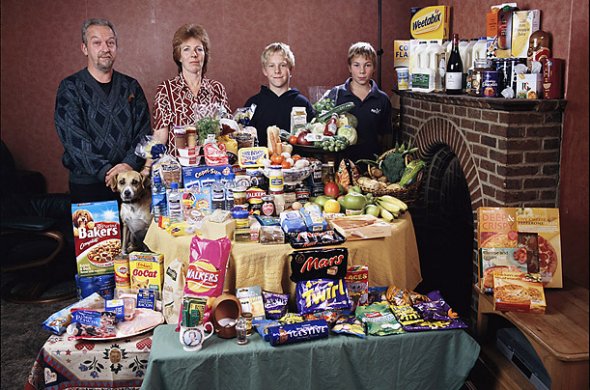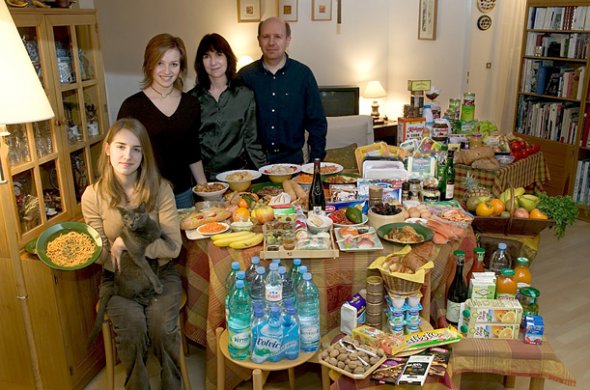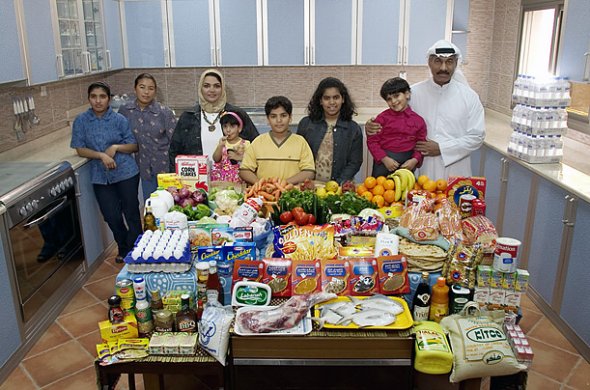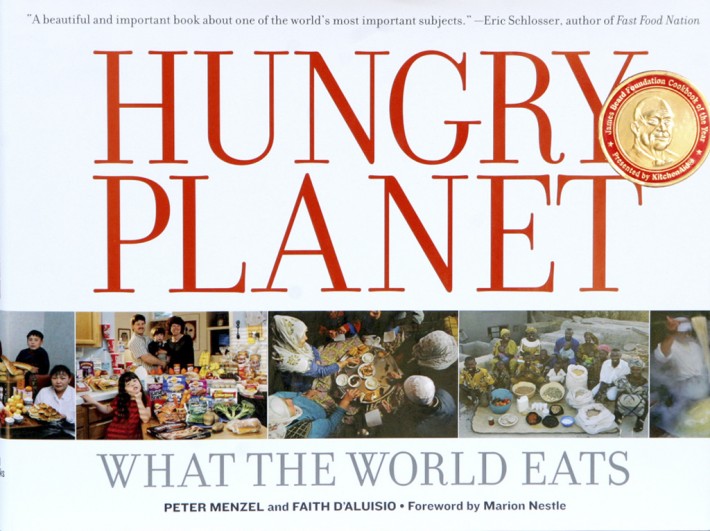It seems as a people, we have a fascination with photographing our food. From Henry's series of riders, to looking on instagram we cant help but document what we consume. Photographer Peter Menzel started this intriguing series of one weeks of groceries from around the world, taking traditional food photography to a much larger scale. In his book Hungry Planet, Peter explores both the cultural differences of diets around the world as well investigating how prosperity and poverty influence the diets of different nations.
Here is the book description of Menzel's amazing project:
The age-old practice of sitting down to a family meal is undergoing unprecedented change as rising world affluence and trade, along with the spread of global food conglomerates, transform eating habits worldwide. HUNGRY PLANET profiles 30 families from around the world--including Bosnia, Chad, Egypt, Greenland, Japan, the United States, and France--and offers detailed descriptions of weekly food purchases; photographs of the families at home, at market, and in their communities; and a portrait of each family surrounded by a week's worth of groceries. Featuring photo-essays on international street food, meat markets, fast food, and cookery, this captivating chronicle offers a riveting look at what the world really eats.

Mexico

Great Britain

USA

Australia

Germany

Italy

Canada

France

Japan

China

Poland

Kuwait

Mongolia

Turkey

View the entire series Here in Menzel's Book Hungry Planet.
If you're passionate about taking your photography to the next level but aren't sure where to dive in, check out the Well-Rounded Photographer tutorial where you can learn eight different genres of photography in one place. If you purchase it now, or any of our other tutorials, you can save a 15% by using "ARTICLE" at checkout.








I enjoyed the photos. It was a great idea. It is obvious which countries eat healthiest.
It looks like the more people eat, the fatter they are, regardless of where they live! I know there must be spices and herbs used each week that are not pictured. Also, it would be helpful to have a list of the items that are pictured.
dude sry but ... are you nuts??? in Ecuador we are not like those guys cmon ok the food pretty cool, healthy just look at this http://www.chanatrek.com/wp-content/gallery/13_Ecuador/2008_10_07_Guayaq... regular people wearing regular cloths cheezuz dog u need to learn something about South american people we are not natives we r not an stereotype
Awesome job - I wouldn't change a thing. Every photographer has the vision for their work - as a budding photographer I can appreciate your vision.
Please also acknowledge that there is a significant modern urban Ecuador, Mali, etc.. it would have been a much better comparison to provide different urban and rural sets of pics
What a horrible representation of the foods eaten in the US...I do not eat junk food, fast food or drink soda and I live here damnit! Lol...my diet consists mostly of fruits and veggies
I think the US has the most junk food. Most of the other countries eat so healthy. More stunning is the countries with the sacks of grain rice, etc. They make homemade meals everyday. Amazing!!!
And my sons school serves very nutritious lunches...my son goes to the salad/veggie bar everyday...plus the meal comes with FRESH veggies..and all bread, tortillas, and buns are whole wheat..even the pizza crust is whole wheat
I like this, but I don't like how people are using it to pass judgement. I wonder if there will ever come a day when people will perceive without judgement. I loved looking at this. TBH I was looking at the smiles and faces more than the food.
I would follow a modal verb with an infinitive.
The Australian one doesn't look anything like my family groceries. Obvious differences are the large bottled water (Australia has quite good quality water, though some people do buy bulk bottled, it isn't common), the bottles of soft drinks and and juices, and that much cereal would last more than a week. All that meat is utterly different too...
That would probably be 1.5 - 2+ weeks maybe?
No worries about the USA newest reports out are that fast food is seeing a decline in profits as well as people buying it. Not sure if people don't have extra cash for it or they are cooking at home. Time will tell. The more people see about eating patterns and how abundant healthy food is in the USA, more people will change. Plus health care costs will start to change peoples opinion. If you eat better and need less medical attention you save what extra cash you have. Plus the education of teenagers is helping.
Looks like the US and Mexico have the most unhealthy pile. Australia looks great! I love how the German photo is so organized. lol.
This places many things in perspective, this will be something to share with my family. It would have been nice to see a list of the items from other countries as to 'what' they are. Along with the cost to really compare. Also, if the family size and ages of children along with the children having the same activity levels. That would have been a good comparison. Growing children eat differently based on what they burn. I have a son whom is 16y and 6'5" and a daughter whom is 7y and 4' 8" tall. They are both athletes, fit, and very active. So they take in more calories than their average counterparts.
I love so much about this, from the families who include their pets in the photo to the organization of the food to getting to see inside people's kitchens/houses to of course, what people eat and how it's packaged.
I think it would be even more relevant if he shot the same size of family every time. Say, 2 adults and two 12 year old children. Otherwise, I think the concept is great.
Wow! Great photos. They really say it so much better than words...
This was an awesome article. Thank you for sharing it.
Since our family doesn't eat processed foods or meat I was drawn to the quantity of fresh foods and grains in the photos. Most of these are quite sad. I would be even more shocked to see the pics taken today with the world economy being what it is.
Interesting... Processed food for the most wealthier nations with a high diversity. Baked good for those less developed region, more seasonal dependent and then into the poorest regions, it's down to the grains that need to be milled. All I have to say that despite the mass amount of food American eat, they literally are the least healthiest.
I'd be interested to see an entire week's worth of food would be to single people around the world.. I'm from the US, and my table of food would be drastically tinier than the US family shown. Miniscule, by comparison, mostly of wheats and flour items.. $30 of food could easily last me well over a week.
amazing`
These photos are from a book by Peter Menzel and Faith
D'Aluisio called Hungry Planet: What the World Eats. Just wanted to be sure proper credit was given...
The cultural relativism of food is clearly exemplified through these photos. You can see the wide variations between western and eastern countries but there is an everpresence of western goods in many of these countries. You can see the fish products are numerous in Japan while fast food dominates the US diet. Aside from food variety, quantities per person is shockingly low in Chad but isn't that part of the culture as well? You can see who is presenting the food and how it may affect their appearance, with regard to weight. The Australians are a bit heavy and it shows with the meat they have on the table while the French look fit and have an absence of processed foods.
I always get excited when I see projects like this because I think it's a very creative idea, but I always get slightly annoyed with their depictions of African nations. Like it always seems to me like they look for the poorest families to depict. I'm not under any impression that poverty doesn't exist in many African nations, but it does in every country too! Sub-saharan countries with a wealthier middle class like Ghana or Nigeria are never shown. Why is that? Things like this just seem to perpetuate the poor African stereotype.
I for one am surprised by the worldwide popularity of bananas, considering the relatively small number of regions bananas are grown. I'm counting 14/20 families with bananas.
Monsanto is pleased by the Americans' choices.
Great idea, worst photographer ever. Jesus.
WOW - look at the amount of fizzy drink some of these families have!
Yeah I think most of those pics don't represent the average family in most of those countries.
The people of Bhutan look happy and healthy, as is reflected in their food choices, fresh fruits and vegetables and not a lot of processed foods. It seems the further people go up the civilization chain, the more unhealthy their food choices are. Progress isn't all it's cracked up to be.
While I agree with your general point, I would be careful calling
certain cultures more "civilized" than others. Places like Bhutan are
not "down the civilization chain" just because they may be less
developed by Western standards. They have a different culture and way of
living, but are no less civilized than other, more money-rich cultures.
Does the number of items depend on the number of people in the family?
2007 the hungry planet http://www.amazon.com/Hungry-Planet-What-World-Eats/dp/0984074422
This would be an interesting project to do longitudinally within a culture -- one photo for each US state, for example, or one for a family at every income decile within the same country.
Wow this is awesome, the perspective and differences are amazing. Being vegan my eyes searched first for who had an abundance of veggies on their tables. Sharing on our green social network www.CrunchyHippie.com ~connecting healthy like minds!
Americans eat like crap (I should know I am one). All I can say is that calories are cheap in America. During the winter, I wouldn't be surprised if I consumed 3500+ calories a day. When you work hard and the weather is cold there's a little part of your brain that whispers "that would taste better with gravy/mayo/extra cheese". During the summer I eat a lot more fruit and almost no red meat, but I know that I don't eat well.
the food in my fridge is a reality check.....
Ingersoll, your ignorance is malicious, selective and plain stupid! If you want to give perspective, be fair! Why would you choose obviously low income Africans and compare them to regular Americans, Asians with proper housing, etc? Why didn't you put relatively poor Americans on food stamps or lower income Chinese homes that eat rats occasionally for the sake of hunger? THAT IS NOT how groceries are in a middle income African home! In such homes, there is a comparable amount of food with less of the junk, maybe more carbs altogether but what you have done here is a reflection of your small mind. Keep re-telling the same old lame story about Africans being poor. You have a voice (albeit minute) to do something different, yet you remain adamant to tell the other side of the single story! Shame, shame shame on you!
I love this! Since I do all my fruits and vegetables at the Organic Market, I sometimes look in horror at my cart when I do a supermarket shop, because there are no fruits and vegetables there. Maybe if we all had to lay out our weekly food, we would try to increase the ratio of fresh, colorful produce to processed stuff.
These photos fail to capture the reality of our world, and the challenges that the "average" family faces to feed their family. All these photos show abundance, and allow us to conclude that, although our crops and diet differ, for the most part we share a wealth of food choices weekly with our family.
But the truth is far different. The majority of people live on $2 a day or less, and often see an empty table at meal time. This photo essay misplaces our attention on diversity instead of need, and it enables us to scrape our excess food from our plates into the garbage guilt-free.
Really? You think the pictures from Chad and Mali look abundant?
I'm surprised that I haven't seen any comments about how much packaged food is in the Japanese picture. I guess like in most places, a family in a big city would probably eat fewer fresh foods than one in a suburb.
I don't believe that is the average American family's groceries. More propaganda to make Americans look bad. I constantly hear how Americans don't eat fresh fruits and veggies which is odd considering everyone I know does. The body/food nazis will love this.
I also disagree with the photo of the USA family's weekly diet. The produce department at Wegman's is always crowded when I shop. I know we're eating our veggies!
Don't know who/where the Australian family is, but seriously, we don't eat that much meat and eggs in Australia!
I can't believe that there are people who think that everyone in a particular country eats alike. Maybe in the poorer countries.
Thanks for sharing - Great stuff.
In alignment with the topic of food, have a feeling this would be of interest to guys here:
http://monceabraham.wordpress.com/2013/05/11/hey-share-my-dabba-will-you/
If my ideas help you, happy to cover your efforts + the change in my blog going forward.
p.s.: Doing this in India now!
Cheers, Monce
Strong correlation between fresh produce and a social structure that provides lots of stay-at-home female people in an extended family to do alla the prep work. Still happens in places in East Asia where polygamy was grandfathered in and you still have lots of grandmas and aunties around.
Fairly certain I've seen this series in print, years and years ago. Time-Life or something like that. Higher res/zoomable for web would be better, so we can actually make out the individual items.